| The House Between: "In the tradition of the original Twilight Zone and early Doctor Who...a series that succeeds on the strength of the writing and the characters...5 people locked into an empty house together......an entertaining and mysterious series that represents what is possible for future online shows." |
| John Kenneth Muir is the author of several books on science fiction and horror in television and movies, such as An Askew View: The Films of Kevin Smith, The Encyclopedia of Superheroes on Film and Television, The Unseen Force: The Films of Sam Raimi, and Horror Films of the 1970s .
He has recently completed writing, directing and producing an independent television series called The House Between, which viewers can see at several places on the web. |
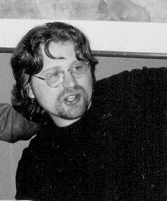 |
| Please give a brief biography.
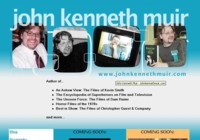
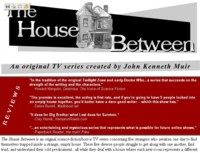
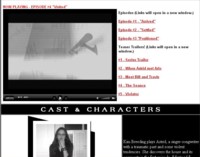
More of The House Within Homepage
|
I was born in Glen Ridge in New Jersey on December 3, 1969 to two teachers, Ken and Loretta. I have an older sister, Lara, who is also artistically-inclined. I have been married to my wife, Kathryn, a psychotherapist, for twelve years. Our first child, Joel, was born October 9, 2006. So he’s almost six months old now….and not yet sleeping through the night.
I’ve been writing short stories and producing my own low budget films as far back as high school in 1987. But my “real” writing career began in 1994, when I was still employed as a pathology transcriptionist, and I submitted to five carefully selected publishers a few chapters of an analytic treatise on the 1970s sci-f series, Space: 1999.
Within a few days, I’d heard back from McFarland in North Carolina and we soon had a contract for me to write the monograph. I was very lucky: fans of Space: 1999 were hungry for a companion guide to the series back then, and the Internet was just hitting it big when the book was released (ten years ago, in 1997.) I often say I owe my writing career to the Internet, because the book took off, and the fans found it. After that, I did a second project for McFarland (on Wes Craven) and then a third, and a fourth…
By 2000, I had an agent in New York, six additional books under my belt, and in the year 2002, I was fortunate to hook up with a second – and wonderful - publisher, Applause Theatre and Cinema Books in Manhattan. Between McFarland and Applause, and also Powys Books in California, I’ve rarely had a free moment since, and the result is that my twenty-first book in ten years will be released in June, TV Year, Volume 1. |

| Tell us about the genesis of your online science fiction/horror televison series, The House Between.
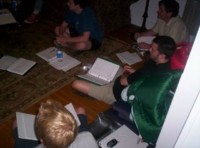
|
The House Between is one of those magical, one-in-a-million enterprises where everything just went perfectly. In 2004, I was a guest speaker at a convention, and I hooked up with this very talented, very passionate group of personalities in Chesapeake, Virginia. They were smart, funny, witty and already a tight-knit group. It’s funny…they were already an ensemble of sorts before they ever appeared on film!
So anyway, I proposed to them in February 2006 that we create a super low budget independent online series together. They were all keen on the idea, and pretty much everyone committed to a week-long shooting schedule on the spot.
My original intention had been to create a series about science fiction fandom and an arrogant writer/guest speaker (to be played by me…) who goes to conventions and makes a fool of himself on stage and with the fans. It would be Curb Your Enthusiasm with a genre twist, and have a lot of sci-fi in-jokes. I was going to do it mockumentary-style, with talking head interviews, which would have been very easy and affordable to shoot.
Very soon, however, I realized that such a premise – while funny – would get old quickly. So I dug back into my endless writing files. Back in 1999 I had written a script leading up to Y2K about a woman who is kidnapped from her car in a parking lot, and wakes up to find herself trapped in a strange house with people from different historical eras. Outside the door is a pulsating force field. So they’re all trapped in this house with no escape. This was a feature script, one where the house was booby-trapped, had hidden passageways, etc. It was called, if I remember correctly, “Last Day.” I resurrected some ideas from this screenplay to create The House Between.
Another source of inspiration for The House Between was the Jean-Paul Sartre play No Exit, which concerns three characters trapped in Hell. In the existentialist drama, Hell was actually a sort of sitting room. The idea of the play was literally “Hell is other people,” to quote one character; that for eternity you have to cope with someone you don’t like, someone different from yourself. And you can never get away from them.
I got to thinking, “hmmm that’s not just Hell…that’s life on Earth!” People who are religious, people who are scientists, lawyers, psychics: we all share the same speck of dust in space, and must find a way to get along here, lest the human race destroy itself. So that underlying metaphor, the house as Earth, became a sub-text, an important crux of the series.
I was also inspired to make a black-and-white “mystery” creep-fest kind of show, based on my love of Rod Serling’s original The Twilight Zone, John Newland’s One Step Beyond and the 1960s version of The Outer Limits. Those productions are antecedents, but we’re not an anthology. But I appreciate how they were written, and I love their b&w look…like transmissions from another dimension. Those shows thrived not on big budgets, but big ideas, and I hope our series accomplishes the same thing.
From the finalized concept to the shooting was approximately a four month duration…an exceedingly short start-up time, even for a no-budget effort. But every step was pretty smooth. Still, up to maybe two weeks before we started, one role still wasn’t cast. |

| For any technoheads reading this interview, what equipment did you use in your filming?
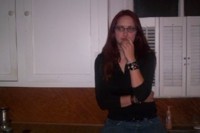
|
We shot with two cameras. The model I used was a Sony DCR-DVD405, a nice but not terribly expensive camera which gives us a nice, clear picture…which I then muddy up with fractures, dust and scratches to make it appear old. We shot on mini-DVD-RWs, which allow about sixty minutes of footage on their lowest quality setting. I edited the show on Sony Vegas Platinum 6.0b, and I’ve incorporated this fantastic – and affordable - special effects platform, called FXHome, which is credited at the end of each episode with effects. We shot with tripods for most episodes, but for the action-oriented shows, like episode three “Positioned,” when we wanted a more immediate feel, we did go hand-held.
We had two lights for the whole show, though I think that number grew to three when I threw in this weird device I called an “artificial sun” because it was so bright. Since the show features virtually no props or furniture, lighting was really important, and Kevin Flanagan and Bobby Schweizer – our lighting directors – came up with a whole scheme for the look of the show. We were so lucky to have them.
The House Between: The Complete First Series DVD will go on sale sometime Summer 07, assuming we keep our schedule. It will feature all seven first season episodes, plus an assortment of extras. I want to include deleted scenes, unshot scenes read by the actors in their roles, all the episode and series trailers (which are on YouTube)), and hopefully some on-camera interviews with the cast and crew. I would like to do episode commentaries, and hopefully include the radio program I did with Howard Margolin, Destinies: The Voice of Science Fiction. |

| Talk about the music Kim Breeding (who plays Astrid) devised for the program.
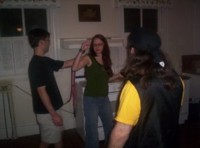
|
Let me just say that Kim is an astonishing talent. She’s the former lead singer of a band called Cured by Porno, she’s an actress, she’s an artist, she’s a composer. There’s nothing she can’t do. Astrid’s song was needed for episode # 2, “Settled” and Kim had maybe a week before we started shooting to come up with something. She composed a haunting, lovely piece called – appropriately “The House Between” - and then recorded it for me in three versions, three variations, if I remember correctly, that we could use on set. So by the time we got to shoot the episode, she was listening to herself sing the song on a recording, which was pretty weird and amazing.
Then, the last day of the shoot, Kim sang the song live for me on our location, an empty house, just to be certain it would have full coverage. I’m in the process of cutting that performance together as a music video. It’ll be on YouTube at some point, and also the DVD. |

| You've made low budget films before. Are they available on YouTube?
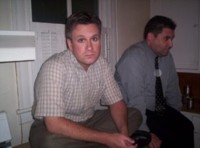 |
Whatever happened to those films? As I like to say, they’re unfit for human consumption. Not all of them. Some are decent. But here’s the rub, in literally each and every case, I was sort of let down by composers who promised me an original soundtrack but for one reason or another, never delivered one. I was caught, high and dry. I couldn’t put up movies without original music, so I was kind of screwed. It was always very disappointing. And sad.
Fortunately, on The House Between, we have two accomplished composers, Cesar Gallegos and Mateo Latosa. Together they’ve composed over one hundred original tunes for the series. They’ve done themes for Astrid, Bill, Theresa, Arlo and Travis, the house itself, and even our “bad guys,” the Outdwellers. It’s amazing…just last week they delivered me the music for the remainder of the season. I love their work, and it has added so much to the program. I get compliments all the time on the music, and for good reason. It helps so much in establishing and maintaining the creepy atmosphere of the stories. |

| You referenced a site called Virtual Fools. What's up with them?
|
I know Bobby and Kevin are hard at work on their scholarly periodical, GameCultural Journal right now, and the upcoming issue is about the science of video games. Last time I checked, they had a link at Virtual Fools to The House Between, but they may have taken that down. Hopefully Virtual Fools will be back, because it’s a great site, with TV/film reviews and other terrific stuff. |

| When you wrote your scripts, did you have an idea in your head of how each scene would be filmed, or did you just write the text and figure you'd do the blocking and staging when it was actually produced?
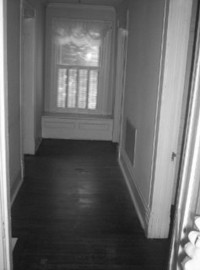
|
My personal, interior mantra on The House Between was always: take each step in turn. That was the only way I could look at an enterprise this complicated without falling apart. If I had to worry about editing and uploading while I wrote the script, I’d never finish the writing. So I wrote the story I wanted to write first. Then I went about figuring out how and where we were going to shoot the program.
Once we had a “real” house to shoot in, some aspects of the scripts had to be tweaked because of the interior layout…some things became impractical or impossible. For instance, my third script “Positioned” is about a character named Travis (Lee Hansen) seizing the kitchen away from the other people trapped in the mysterious house. He locked and the door and wouldn’t come out.
Well, wouldn’t you know, once we got the house we found there was no door on the kitchen. That could have scuttled the script, but the kitchen was attached to another room, and so he locked the others out of that room too. When you’re making a film on such a low budget, you have to be flexible.
My director of photography, Rick Coulter, and I did scout out the location and do test shots on the tripods, and do a few sound tests. We also compiled a complex, highly-detailed shot list for the first two episodes. Once we got shooting, however, it became impractical to use them because we were just moving so, so fast.
Joe Maddrey, our producer, has worked on series such as A Haunting and Survive This! And he was a tremendous asset to have on the set. Not just because he’s a gentle soul, and could figure out how to solve production dilemmas and trim down vast amounts of dialogue, but because he always encouraged everybody. He’d been on “real” network productions before, and assured us we weren’t under the threshold they had established. I don’t know if that’s actually true, but it sure made us all feel good. Seriously, he’s an amazing guy.
But back to your question, I’ve learned each step as I’ve gone. I wrote. Then I blocked. Then I shot and directed. Then I learned to edit. Then I learned the special effects program. Then I learned how “encode.” Then I learned how to upload. And on and on. I could probably teach a class about independent film production by now… |

| How did you assemble your actors?
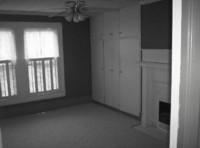
|
I have nothing but high praise for all the actors, because they really gave the series their all. They all come from different creative backgrounds. Kim Breeding, our star Astrid, is a singer and has done stage work before, particularly musical theater, I think. Lee Hansen, who plays Travis, was a popular radio personality in Virginia. Tony Mercer, who plays Bill, has stage experience too. He recently starred in an Agatha Christie mystery playing in Virginia Beach. Jim Blanton, who plays Arlo, is a librarian by profession, and a film scholar…but he’s a gifted actor in his own right. The same goes for Alicia A. Wood, who is introduced in this show. I don’t think she had acted before, but you wouldn’t know that from her level of assurance and grace.
We didn’t do auditions. I had known most these people for almost two years, and I had a sense what they could each achieve. It was just a matter of: did they want to do it? And – would they crack under the pressure? To their everlasting credit, nobody cracked. I’ve been on film sets before where people have cracked and it isn’t fun. |

| Please describe the filming process. Any blooper reels, etc.?
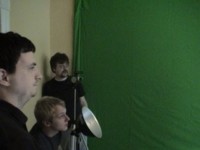 |
Unfortunately, we have very little “prep” footage. Most of what we shot is for the actual episodes, simply because filming media, even DVD-RWs is expensive. I think I went through four or five discs just per episode. That starts to add up quickly,.
But what happened on the day we shot “Mirrored” is that everyone felt so confident and assured in their roles that we could take time to improvise a little; go off script. Find new things. Take a moment to do something in an unconventional or new way. It turned out great, and I would guess everybody remembers that day as their favorite of the shoot. It was day and episode 5. |

| Are you going to be showing the complete series at any conventions in the coming year? If so, which ones? |
I do hope to take the series around the country, as soon as possible. I’d like to take it to I-Con next year. I’d like to do a seven episode marathon at this year’s Fantasci, if it’s feasible. I want to go to DragonCon and other places too. Right now none of that is in place: I’m still just concentrating on getting the show on the air! Again, back to my mantra: one step at a time! |

| A brief segue....What are your thoughts on the new Galactica? And the new Doctor Who?
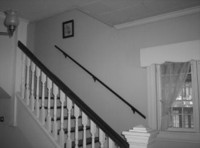
|
I absolutely adore the new Doctor Who. I think it’s terrific. It wows me all the time.
On Battlestar Galactica – I’m bracing myself for the brickbats!! You have to understand, I’m an old guy – 37 years old. So I remember the old series and still boast nostalgic affection for it, warts and all. So Starbuck a woman? Colonel Tigh a drunk? Cylons are now human in appearance? That was all tough enough to swallow, but when the series – ostensibly set in another solar system (meaning all the characters are aliens…) – began to include dialogue snippets from Top Gun (“I feel the need for speed…”) and Patton, I began to get agitated. How would they know Hollywood movies? Intergalactic Netflix?
Generally, I also find the series a little too on the nose in terms of contemporary politics. I think the series tries way too hard to mirror real life events (September 11, Abu-Ghraib) rather than putting focus where it should be: on its own precarious sense of internal consistency. For instance, Number Six’s Cylon spine glows red when she has sex. Don’t you think Baltar would have noticed that affectation, given a certain *ahem* position? Also, after a few episodes with Baltar raving and talking to the invisible Number Six in plain view of the other dramatis personae and nobody catching on…I began to feel like all the other characters were idiots. I felt that the show was trying to make political points but not focusing strongly enough on the integrity of the characters and individual storylines.
I realize I’m in the minority in holding these views, and I’m certainly happy so many people like the series. I can watch it any time and be entertained, but I don’t think it’s half as good as Doctor Who. Haven’t seen Torchwood [a Doctor Who spin off] yet… |

| Please describe the scripting process for The House Between |
Each episode of The House Between was between 33 and 38 pages, with the last episode being significantly shorter, because we didn’t shoot a cliffhanger ending that we had originally intended to use. I had three endings, and we filmed two instead of three.
The actors made the character voices their own in short order, meaning that they did change lines when it made sense. I don’t think there was much ad-libbing. Instead, we’d rehearse, and Tony Mercer would say to me during three page speeches– only half-joking - I think: “you can write this shit, but you can’t say it.” That’s okay, he’ll pay for his heresy. I’m writing elaborate, tech-heavy monologues for him as I speak. I’m just kidding of course. It was all good natured stuff. |

| Did you film it in time sequential sequence, or did you do all of one characters scenes, then another character's scenes, etc.? |
Filming went miraculously well. We filmed the episodes in sequential order, because I wanted the viewer and actors to be on the same page: they’d be getting familiar with the other characters more and more each show. As the actors grew more comfortable in their roles, the audience would also be more comfortable with each person. We pretty much shot episodes sequentially, in order. Except when there were elaborate special effects that could hang us up. For “Settled” there was a scene where Astrid had to talk to a double of herself in a bath tub, and we ended up shooting that at 2:00 in the morning! Also, by the end of the shoot, Joe was saving us time by having us shoot all the first floor scenes at one time, and then all the second floor scenes. But I think that only happened days five and six, if I remember correctly. |

| You edited out a lot of footage. Is it gone for good, or have you saved it for a "Director's Cut" for the future? |
It’s weird. The impulse of an editor is much different from that of a writer. As a writer, you just want to keep going deeper, layering on and on. As an editor, you can see that everything works better when there’s less material; when the whole enterprise moves more quickly. Less really is more. The actors say a lot with their expression, in their tone, so you don’t need so much exposition to explain things. Audiences pick up on things faster than writers realize sometimes. At least this writer! That’s been an important lesson.
We lost five minutes in “Settled.” We lost at least that much, possibly more, in episode four “Visited.” The missing material in “Settled” is interesting and character-based, so I’m sure it will appear somewhere on the DVD. In “Visited,” the extra footage tends to belabor a point, or over-explain something, so there’s not tremendous value in it that I can see. |

| Are you already writing the scripts for Season Two? |
You bet. I just finished the revision of the first script, “Returned”…and the general consensus is that it’s very strong. We had a few character issues but I think they’ve been resolved, hopefully to everyone’s satisfaction.
I’m working on the second episode, called “Separated” and it’s going to be a very funny, rollicking kind of episode. We start shooting the second season May 25, 2007…which is just around the corner. I can’t wait. Jim, who plays Arlo, said that our second season will be to the first as Aliens was to the original Alien, and that’s a comparison I like. |

and finally...
"A couple of years I proposed a film reference book called Die Hard in a Book, which studied all the variations of the Die Hard scenario, such as Under Siege, Speed, Passenger 57, and the like. There were no takers, alas, but while preparing for the book, I catalogued all the common "conventions" of the Die Hard action sub-genre. When writing "Positioned" I incorporated many of those commonalities. I'm sure you'll recognize a few standards."
Sounds interesting to me! Too bad no one picked up on this book!
I would have loved to do that book. I thought it was a slam-dunk. It would have been very entertaining. Maybe someone will read this and get excited by the idea…
|












